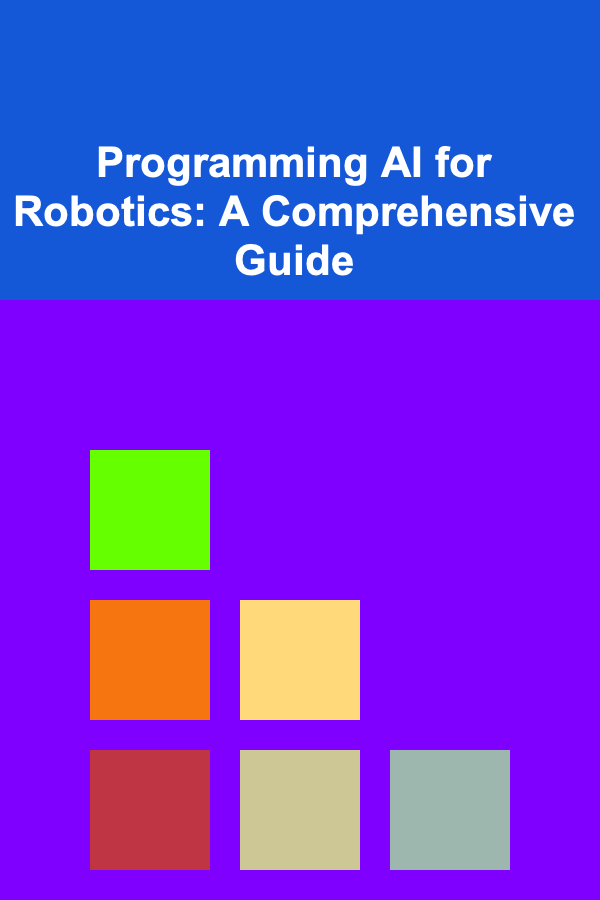
Programming AI for Robotics: A Comprehensive Guide
ebook include PDF & Audio bundle (Micro Guide)
$12.99$5.99
Limited Time Offer! Order within the next:

The intersection of Artificial Intelligence (AI) and Robotics represents a transformative frontier in technology, enabling machines to not only perform tasks but also to learn, adapt, and make decisions autonomously. Programming AI for robotics involves a complex interplay of algorithms, sensors, actuators, and software architectures, demanding a deep understanding of both AI principles and the practical constraints of physical systems. This guide provides a comprehensive exploration of the key concepts, techniques, and challenges involved in programming AI for robotics, covering topics from perception and planning to control and learning.
I. Foundations: Understanding AI in Robotics
Before delving into specific programming techniques, it's crucial to understand the core AI disciplines that underpin robotic intelligence. These include perception, planning, control, and learning, each contributing a vital piece to the overall intelligent behavior of a robot.
A. Perception: Making Sense of the World
Perception allows robots to gather information about their environment through sensors like cameras, LiDAR, sonar, and tactile sensors. AI algorithms are then used to process this raw sensor data and extract meaningful information about the world, such as:
- Object Recognition: Identifying and classifying objects in the environment (e.g., recognizing a chair, a table, or a person). This often involves techniques like Convolutional Neural Networks (CNNs) trained on large datasets of images.
- Scene Understanding: Constructing a 3D representation of the environment, including the location and relationships between objects. SLAM (Simultaneous Localization and Mapping) is a common approach for building maps while simultaneously estimating the robot's pose within the map.
- Sensor Fusion: Combining data from multiple sensors to create a more robust and accurate understanding of the environment. Kalman filters and Bayesian networks are frequently used for sensor fusion.
- Human Detection and Tracking: Identifying and tracking humans in the environment, which is essential for robots that interact with people. Techniques often involve using depth sensors and computer vision algorithms.
The challenges in perception include dealing with noisy sensor data, varying lighting conditions, occlusions, and the need for real-time performance. Robots must be able to accurately perceive the world even in uncertain and dynamic environments.
B. Planning: Deciding What to Do
Planning involves generating a sequence of actions that will enable the robot to achieve a desired goal. This requires the robot to reason about the consequences of its actions and choose a plan that is both feasible and efficient.
- Path Planning: Finding a collision-free path from a starting point to a goal point in the environment. Algorithms like A*, Dijkstra's algorithm, and Rapidly-exploring Random Trees (RRTs) are commonly used for path planning.
- Task Planning: Breaking down a complex task into a sequence of simpler actions that the robot can execute. Hierarchical Task Networks (HTNs) and Planning Domain Definition Language (PDDL) are used to represent tasks and plan their execution.
- Motion Planning: Generating the detailed trajectories of the robot's joints to execute a desired motion. Motion planning algorithms must take into account the robot's kinematics, dynamics, and constraints on its joints.
- Goal-Oriented Action Planning (GOAP): Planning sequences of actions based on world states and desired goals. This allows robots to dynamically adapt their plans as the environment changes.
Planning algorithms must address issues such as computational complexity, dealing with uncertainty, and adapting to changing environments. The choice of planning algorithm depends on the complexity of the task and the characteristics of the robot's environment.
C. Control: Executing the Plan
Control involves implementing the planned actions by sending commands to the robot's actuators (e.g., motors, grippers). The control system must ensure that the robot accurately follows the planned trajectory and compensates for disturbances.
- PID Control: A classic feedback control algorithm that adjusts the robot's actions based on the error between the desired state and the actual state.
- Model Predictive Control (MPC): An advanced control technique that predicts the future behavior of the robot and optimizes the control actions to achieve a desired goal.
- Force Control: Controlling the forces exerted by the robot on its environment, which is important for tasks such as assembly and manipulation.
- Adaptive Control: Adjusting the control parameters in response to changes in the robot's environment or its own internal state.
Control systems must deal with issues such as delays, noise, and the inherent uncertainty in the robot's dynamics. Robust control techniques are essential for ensuring that the robot performs reliably in real-world conditions.
D. Learning: Improving Over Time
Learning enables robots to improve their performance over time by learning from experience. Machine learning algorithms can be used to learn models of the environment, optimize control parameters, and discover new strategies for solving tasks.
- Reinforcement Learning (RL): Learning to make decisions by interacting with the environment and receiving rewards or penalties for each action. RL is particularly well-suited for learning complex tasks where the optimal strategy is not known in advance.
- Supervised Learning: Learning a mapping from inputs to outputs based on labeled training data. Supervised learning can be used for tasks such as object recognition and state estimation.
- Unsupervised Learning: Discovering patterns and structure in unlabeled data. Unsupervised learning can be used for tasks such as clustering and dimensionality reduction.
- Imitation Learning: Learning to imitate the behavior of an expert by observing their actions. Imitation learning is useful for tasks where it is difficult to define a reward function or to collect large amounts of training data.
The challenges in robot learning include dealing with high-dimensional state spaces, sparse rewards, and the need for real-time performance. Robot learning algorithms must be able to generalize from limited training data and adapt to new environments.
II. Programming Languages and Frameworks
Choosing the right programming languages and frameworks is crucial for developing robust and efficient AI-powered robotic systems. Here's an overview of the most popular options:
A. Programming Languages
- Python: The most popular language for AI and robotics due to its readability, extensive libraries (NumPy, SciPy, scikit-learn, TensorFlow, PyTorch), and ease of integration with other systems. Python is often used for high-level planning, perception, and machine learning tasks. Its dynamic typing and large community support make it ideal for rapid prototyping and development.
- C++: Essential for performance-critical applications, such as real-time control and low-level sensor processing. C++ provides fine-grained control over hardware and memory management, making it suitable for embedded systems and computationally intensive tasks. The Robot Operating System (ROS) heavily relies on C++.
- Java: Used in some robotics applications, particularly those involving distributed systems and cloud integration. Java's platform independence and strong ecosystem make it suitable for developing cross-platform robotic applications.
- MATLAB: A powerful tool for prototyping and simulation, particularly in control systems and signal processing. MATLAB provides a rich set of toolboxes for robotics, image processing, and machine learning. However, it is less commonly used for deployment in real-world robotic systems.
- Rust: A modern systems programming language that offers a balance of performance, safety, and concurrency. Rust is gaining popularity in robotics due to its ability to prevent memory errors and data races, making it suitable for safety-critical applications.
The choice of programming language often depends on the specific requirements of the application. Python is generally preferred for high-level tasks and prototyping, while C++ is preferred for performance-critical tasks and low-level control.
B. Robotics Frameworks
- ROS (Robot Operating System): A meta-operating system that provides a framework for building robot software. ROS provides a collection of tools, libraries, and conventions that simplify the development of complex robotic systems. It includes features for message passing, hardware abstraction, and visualization. ROS supports multiple programming languages, including C++, Python, and Java.
- ROS2: The next generation of ROS, designed to address the limitations of ROS1, such as single point of failure and lack of real-time support. ROS2 provides improved security, performance, and scalability, making it suitable for a wider range of robotics applications.
- Gazebo: A widely used 3D robotics simulator that allows developers to test and debug their robot software in a realistic environment. Gazebo supports various sensors, actuators, and physics engines, enabling realistic simulations of robot behavior.
- Webots: A professional mobile robot simulator used in industry and academia. It offers a wide range of features, including realistic physics simulation, sensor modeling, and support for various robot platforms.
- OpenAI Gym: A toolkit for developing and comparing reinforcement learning algorithms. OpenAI Gym provides a collection of environments, including robotic manipulation tasks, that can be used to train and evaluate RL agents.
- MoveIt!: A motion planning framework built on top of ROS that provides tools for collision detection, path planning, and trajectory optimization. MoveIt! simplifies the development of robot manipulation applications.
Robotics frameworks provide a standardized environment for developing and deploying robot software, reducing the complexity of building complex robotic systems. ROS and ROS2 are the most widely used robotics frameworks, providing a rich ecosystem of tools and libraries.
III. Key AI Algorithms for Robotics
A deep understanding of specific AI algorithms is essential for implementing intelligent behaviors in robots. Here's a look at some of the most important algorithms:
A. Computer Vision
- Convolutional Neural Networks (CNNs): Used for image recognition, object detection, and image segmentation. CNNs learn hierarchical features from images, enabling them to recognize complex patterns. Popular CNN architectures include AlexNet, VGGNet, ResNet, and YOLO.
- Object Detection Algorithms (YOLO, SSD, Faster R-CNN): Used to identify and locate objects in images. These algorithms are essential for robots that need to interact with objects in their environment.
- SLAM (Simultaneous Localization and Mapping): Used to build a map of the environment while simultaneously estimating the robot's pose within the map. Visual SLAM uses cameras as the primary sensor, while LiDAR SLAM uses LiDAR sensors.
- Optical Flow: Used to estimate the motion of objects in a video sequence. Optical flow can be used for tasks such as tracking objects and detecting moving obstacles.
Computer vision algorithms enable robots to "see" and understand their environment, providing crucial information for planning and control.
B. Planning and Decision Making
- A Search Algorithm:* A graph search algorithm that finds the shortest path from a starting node to a goal node. A* uses a heuristic function to estimate the cost of reaching the goal from each node, guiding the search towards the most promising paths.
- Rapidly-exploring Random Trees (RRTs): A sampling-based path planning algorithm that builds a tree of random configurations until a path to the goal is found. RRTs are particularly well-suited for planning in high-dimensional configuration spaces.
- Markov Decision Processes (MDPs): A mathematical framework for modeling sequential decision-making problems. MDPs can be used to represent the robot's environment, actions, and rewards, allowing the robot to learn an optimal policy for achieving its goals.
- Reinforcement Learning (RL): Algorithms like Q-learning, Deep Q-Networks (DQNs), and Proximal Policy Optimization (PPO) are used to train robots to perform tasks through trial and error. These algorithms learn to maximize a reward signal by interacting with the environment.
- Behavior Trees: A hierarchical control architecture that allows robots to perform complex tasks by combining simpler behaviors. Behavior trees provide a modular and reusable way to design robot control systems.
Planning and decision-making algorithms enable robots to reason about their actions and choose the best course of action to achieve their goals.
C. Control Algorithms
- PID Control: A feedback control algorithm that adjusts the robot's actions based on the error between the desired state and the actual state. PID control is widely used in robotics due to its simplicity and effectiveness.
- Model Predictive Control (MPC): An advanced control technique that predicts the future behavior of the robot and optimizes the control actions to achieve a desired goal. MPC is particularly well-suited for controlling robots with complex dynamics and constraints.
- Kalman Filters: Used to estimate the state of a system from noisy sensor measurements. Kalman filters are widely used in robotics for state estimation, sensor fusion, and tracking.
- Adaptive Control: Adjusting the control parameters in response to changes in the robot's environment or its own internal state. Adaptive control is essential for robots that operate in uncertain and dynamic environments.
Control algorithms enable robots to execute planned actions accurately and reliably, compensating for disturbances and uncertainties.
IV. Practical Considerations and Challenges
Developing AI for robotics involves addressing several practical considerations and challenges, including:
A. Real-Time Performance
Robotic systems often require real-time performance, meaning that the robot must be able to process sensor data, plan actions, and execute control commands within a strict time limit. Meeting real-time requirements can be challenging, particularly for complex AI algorithms. Techniques for achieving real-time performance include:
- Optimizing algorithms: Choosing efficient algorithms and optimizing their implementation to reduce computation time.
- Using parallel processing: Distributing the computational load across multiple processors or cores.
- Hardware acceleration: Using specialized hardware, such as GPUs or FPGAs, to accelerate computationally intensive tasks.
- Real-time operating systems (RTOS): Using an RTOS to ensure that tasks are executed with predictable timing.
B. Handling Uncertainty
Robotic systems operate in uncertain environments, where sensor data may be noisy, the robot's dynamics may be unknown, and the environment may change unexpectedly. AI algorithms must be able to handle this uncertainty to ensure robust and reliable performance. Techniques for handling uncertainty include:
- Probabilistic methods: Using probabilistic models to represent uncertainty and reason about its effects.
- Robust control: Designing control systems that are insensitive to disturbances and uncertainties.
- Adaptive control: Adjusting the control parameters in response to changes in the environment or the robot's own internal state.
- Fault tolerance: Designing systems that can continue to operate even in the presence of faults or failures.
C. Safety and Reliability
Robotic systems must be safe and reliable, particularly in applications where they interact with humans or operate in hazardous environments. Safety considerations include:
- Collision avoidance: Ensuring that the robot does not collide with its environment or with humans.
- Fault detection and recovery: Detecting and recovering from faults or failures in the robot's hardware or software.
- Emergency stop mechanisms: Providing mechanisms for stopping the robot in case of an emergency.
- Formal verification: Using formal methods to verify the correctness and safety of the robot's software.
D. Data Acquisition and Annotation
Many AI algorithms, particularly those based on machine learning, require large amounts of data for training. Acquiring and annotating this data can be a significant challenge, particularly for robotic applications where data may be expensive or difficult to obtain. Techniques for addressing this challenge include:
- Simulation: Using simulation to generate synthetic data for training.
- Active learning: Selecting the most informative data points for annotation, reducing the amount of data that needs to be labeled.
- Transfer learning: Transferring knowledge learned from one task or domain to another.
- Crowdsourcing: Using crowdsourcing platforms to annotate data.
E. Embodied AI and Sim-to-Real Transfer
Embodied AI focuses on developing AI algorithms that are specifically designed for physical robots. A key challenge in embodied AI is the "sim-to-real" transfer problem, which refers to the difficulty of transferring knowledge learned in simulation to the real world. The differences between the simulated and real environments can cause AI algorithms that work well in simulation to fail in the real world. Techniques for addressing the sim-to-real transfer problem include:
- Domain randomization: Training AI algorithms in simulation with a wide range of variations in the environment, forcing them to learn robust and generalizable policies.
- System identification: Developing models of the robot's dynamics and environment that are accurate enough to be used for control and planning.
- Adaptive control: Adjusting the robot's control parameters in response to changes in the environment or the robot's own internal state.
V. Future Trends
The field of AI for robotics is rapidly evolving, with several exciting trends on the horizon:
- Explainable AI (XAI): Developing AI algorithms that are transparent and explainable, making it easier for humans to understand and trust the robot's decisions.
- Human-Robot Collaboration (HRC): Developing robots that can work safely and effectively alongside humans in shared workspaces.
- Edge Computing for Robotics: Moving AI processing from the cloud to the robot itself, enabling faster response times and greater autonomy.
- AI-Powered Swarm Robotics: Coordinating large groups of robots to perform complex tasks, such as search and rescue or environmental monitoring.
- Lifelong Learning for Robots: Enabling robots to continuously learn and adapt to new environments and tasks throughout their lifespan.
These trends promise to revolutionize the way robots are used in a wide range of applications, from manufacturing and logistics to healthcare and exploration.
VI. Conclusion
Programming AI for robotics is a challenging but rewarding endeavor. By understanding the core AI disciplines, choosing the right programming languages and frameworks, and mastering key AI algorithms, developers can create intelligent robots that can solve a wide range of real-world problems. While challenges remain, ongoing research and development efforts are paving the way for a future where robots play an increasingly important role in our lives. Embracing a multidisciplinary approach, combining expertise in AI, robotics, and software engineering, is crucial for advancing this transformative field.

Best Affordable Fitness Options for Busy People: An Actionable Guide
Read More
Effective Tips for Lowering Childcare Costs Without Sacrificing Quality
Read More
How to Encourage Collaboration in Shared Space Organization
Read More
How To Leverage the Power of Flow State
Read More
Mastering Graphic Design: Techniques and Trends for the Modern Graphic Designer
Read More
How to Build a Raspberry Pi Powered Time-Lapse Camera
Read MoreOther Products

Best Affordable Fitness Options for Busy People: An Actionable Guide
Read More
Effective Tips for Lowering Childcare Costs Without Sacrificing Quality
Read More
How to Encourage Collaboration in Shared Space Organization
Read More
How To Leverage the Power of Flow State
Read More
Mastering Graphic Design: Techniques and Trends for the Modern Graphic Designer
Read More